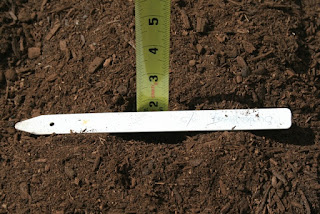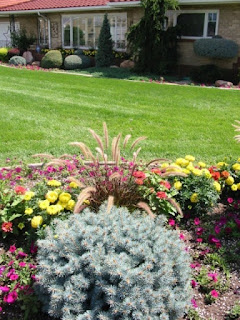Having a great lawn year after year begins with
the idea that the best defense against weeds and diseases is a strong, healthy
lawn. Best practices for building a healthy lawn include core aeration, twice a
year applications of humic acid and
Revive, fertilizing four times a year,
mowing at a higher setting and mowing more frequently and watering for longer
periods of time and less frequently. An important aspect of best lawn practices
is to use products that feed your lawn and help prevent weeds from showing up
in the first place. These products are called pre-emergents. Pre-emergents work
by allowing the seed to germinate, then killing the young plant before it has a
chance to get established. Now is the time to apply a pre-emergent.
Fertilome's For All Seasons II feeds your
lawn and acts against any seed that may have wintered over in your grass. It's
important to note that For All Seasons II, just like every pre-emergent acts
the same with all seeds, not just crabgrass and other weed seeds. If you're
planning to over-seed your lawn this spring, you don't want to use For All
Seasons II. Instead, use Fertilome's New Lawn Starter to get your new grass off
to a good start. Timing is important when applying For All Seasons II.
Pre-emergents need to be applied before the ground temperatures get warm enough
for seeds to start sprouting. Typically, this is before mid-April. When the Forsythia
bushes begin blooming is another indicator it's time to apply pre-emergents.
It's important to apply For All Seasons II evenly across your lawn. Follow the
package instructions. We'll also help you get the right spreader settings. Once
applied, you must water the lawn in order to activate the pre-emergent. Fertilome's
For All Seasons II is part of The Flower Bin's 4-Step lawn care program. Buying
the 4-step program qualifies for a 20% cost savings to you. Pre-emergents are
also available for use in perennial beds and gravel areas. Keeping weeds from
getting started means less yard maintenance for you and a great lawn all season
long. www.theflowerbin.net
www.theflowerbin.net
Thursday, March 30, 2017
Thursday, March 23, 2017
Cool Weather Crops
March is the start of the spring gardening season. Many cool weather crops can be planted outside now as seeds or vegetable starts. What we plant from late March into April?
We can plant many cool weather vegetable seeds directly in the ground. Beets, broccoli, cabbage, kale, lettuce, peas, spinach, turnips like the cooler spring temperatures and can be planted from seed now.
You can also plant vegetable starts now, just be sure you harden them off before you plant them. Onions and garlic can also be planted now.
Onions are planted from seed, sets and plants.
Garlic is planted from individual cloves.
Potatoes should be planted later in April. Egg-sized seed potatoes can be planted whole. Larger seed potatoes can be cut in half or quartered and then planted. Make sure you have at least one set of "eyes" on each piece you plant. Always select certified seed potatoes. Supermarket potatoes are often treated to prevent them from sprouting. This is the time to plant perennial vegetables, including rhubarb and asparagus.
Rhubarb is available as bare root crowns or as rooted starts. Asparagus is available now as bare-root crowns. Don't harvest rhubarb or asparagus during their first season. This will allow the plant to establish. Rhubarb and asparagus can produce for 10 years or more, so pick a spot in the garden where they won't be disturbed for many seasons.
Before planting your seeds, starts or crowns, amend your soil with compost and peat moss. Take the bags home, dump into a pile, mix it all together and add to your vegetable garden.
Add some vegetable fertilizer to your soil while you're planting. Place some in the bottom of each row or planting hole, so the roots of your new plants can grow into it. While you're at it, plant some pansies and violas for color. Thursday, March 16, 2017
Your best garden starts now
Amending
your garden soil in early spring is key to having a healthy, productive tomato
and vegetable crop this season. A good soil amendment will make your existing
soil healthier and more fertile by improving soil texture, helping to lower pH (make your soil more acidic) and
encouraging worms and microbes to flourish. Healthy soil encourages deeper
root systems and makes nutrients more available to your vegetables.
An easy way
to improve your soil is with packaged products such as Earth Essentials Sheep,
Peat & Compost.
In this example,
we're working on improving a 10 square foot (5' X 2') section which will be
used to grow heirloom tomatoes this season.
After opening the bag of Earth
Essentials Sheep, Peat & Compost and spreading the contents evenly across
our bed, you can see that 1 cubic foot bag of Sheep, Peat & Compost organic
compost will cover 10 square feet (5X2) 2" deep. You can use this as a
basis for calculating how much you'll need to buy to amend your current bed or
start a new vegetable bed.
Other choices for bagged soil amendments include
Canadian Peat Moss,
Earth Essentials Cow and Compost,
Nature's Yield Organic Compost and
Sunleaves Coconut
Coir. At this point, you can add some
Peat Moss or Coconut Coir to the mix to help acidify the bed even more.
Tomatoes and most plants do best when the pH is acidic, somewhere around 6.8.
Your best bet to lower your soil's pH is with organic material such as compost,
peat moss and coconut coir.
It's also a
good idea to incorporate a granular fertilizer such as Fertilome's Gardener's
Special or Fox Farm Tomato and Vegetable Fertilizer. This will help feed your
tomato and vegetable starts when you plant them.
The next step is to your incorporate your
compost, peat and fertilizer into the existing soil to a depth of 4" to
6". 2/3rds soil to 1/3rd compost is a good rule of thumb when you're
adding amendments to your soil. Finish the project by raking the bed out
evenly.
Now you are ready to set up your Wall O' Water plant protectors. Wall
O' Water plant protectors act like mini greenhouses and extend your growing
season by six to eight weeks. Set them up a couple of weeks before your plant
your tomatoes. This will help warm up the soil and reduce transplant shock. Hot
Kaps are another way to protect young plants from Spring's cooler weather.
Happy gardening!
Thursday, March 9, 2017
March garden chores
Eager
to get out in the garden? Now is a great time to get your garden ready for the
season ahead.
First, finish cleaning up your vegetable garden and perennial
beds. This includes removing any dead vegetation and debris. Insects and
disease can winter over and you'll help reduce potential problems later on by
doing a good clean up now.
Prune fruit and shade trees while they're still
dormant. This is a great time to prune because you can see the tree's structure
clearly. You're looking for any broken, damaged or diseased branches.
Prune
these out using a sharp pair of pruning shears or loppers.
Next, prune out any
branches that are sticking straight up or crossing other branches.
Finally,
remove any branches that are coming up around the trunk.
Prune summer flowering shrubs such as
buddleia and caryopteris now. Wait to prune spring blooming shrubs such as
lilacs, forsythia, and spiraea until after they bloom. Hold off pruning your
roses. This is done later in the spring season.
Test your soil. You can do this
yourself with a test kit or stop in and pick up a Soil test kit from CSU.
Freshen up your garden beds by adding organic material such as compost and peat
moss. Put 2" of amendments on your beds and work it in 4" to 6".
Apply dormant oil. Dormant oil is very effective to control insects that may be
wintering over in your trees and shrubs.
Have the lawn aerated and apply Soil
Activator.
Soil activator helps improve the soil and helps your grass take up
nutrients more effectively.
Next, add Fertilome All Seasons to your lawn. This
will feed your lawn and help prevent crabgrass and other weed seeds from
germinating. Plant some cool season crops. Cabbage, onions, lettuce, peas,
radishes and many other vegetable crops can be planted now, either from seed or
starter plants.
Keep your
eye on the weather. If it stays dry, get the hose out and water your trees,
shrubs, perennials and lawns. March is a great time to be active in your garden. All the work you do now will lead to a better
gardening season this year.
Thursday, March 2, 2017
4 Steps to a great lawn
The Flower Bin Lawn Care
program
In
order for your lawn to look its best spring, summer and fall, it needs
nutrients. The Flower Bin Lawn Care program is built on the idea that regular
fertilization, along with good mowing and watering practices is the key to
maintaining a strong, healthy lawn. A healthy lawn is more likely to have fewer
weed and disease problems.
That’s why we introduced The Flower Bin Lawn Care
program. The Fertilome® brand of lawn and garden products is the mainstay of
our program and includes four steps designed to keep your lawn healthy
throughout the growing season. When you purchase all four bags of The Flower
Bin Lawn Care program at once, you will save 20% of the cost of the program and
you will continue to save 20% on every Fertilome® product you purchase
throughout the year, including a wide selection of garden fertilizers, insect
and weed controls. Additional benefits of the program include the satisfaction
of knowing you are applying the right product for your lawn at the right time
of the season, when it will benefit your lawn the most.
The program begins with
Step 1, Fertilome’s® For All Seasons II fertilizer and weed preventer. One of
the most effective ways to control weeds in your lawn is to prevent them from
showing up in the first place and this product works to keep weed seed from
germinating.
This includes crabgrass. Step 1 is applied between mid-March and
mid-April.
Weed-Out Plus Lawn Fertilizer is step 2. This product works to
control weeds you can see. It’s called a post-emergent.
This is the product to
apply for dandelions, mallow and other weeds you can see in your lawn. Weed-Out
Plus also feeds your lawn and is applied around the first of June.
Step 3 is Lawn Food Plus Iron and this is
applied in early August, right when your lawn needs nitrogen and iron.
Step 4
is Winterizer and this step is applied around Halloween, when your grass is storing up
energy for the winter weather ahead.
This gives your lawn a head start in spring. Stop in and learn how The
Flower Bin Lawn Care program will help your lawn become thicker, healthier and
more weed and disease resistant.
Subscribe to:
Posts (Atom)











































